Real-Time Voltage Stability Assessment Method for the Korean Power System Based on Estimation of Thévenin Equivalent Impedance
Abstract
:1. Introduction
2. Materials and Methods
2.1. Power System Network Remodeling
2.2. Thévenin Equivalent Circuit
2.3. Voltage Stability Margin Calculation
2.4. Load Modeling for Voltage Stability Margin
The Nose Curve Applying the Load Modeling
3. Results and Discussion
3.1. Case 1
3.2. Case 2
3.3. Voltage Stability Margin
3.4. Discussion
4. Conclusions
Author Contributions
Funding
Conflicts of Interest
References
- Van Cutsem, T. Voltage instability: Phenomena, countermeasures, and analysis methods. Proc. IEEE 2000, 88, 208–227. [Google Scholar] [CrossRef]
- Taylor, C.; Erickson, D.; Martin, K.E.; Wilson, R. WACS-wide-area stability and voltage control system: R&D and online demonstration. Proc. IEEE 2005, 93, 892–906. [Google Scholar]
- Sinha, A.K.; Hazarika, D. A comparative study of voltage stability indices in a power system. Int. J. Electr. Power Energy Syst. 2000, 22, 589–596. [Google Scholar] [CrossRef]
- Zarate, L.; Castro, C. A critical evaluation of a maximum loading point estimation method for voltage stability analysis. Electr. Power Syst. Res. 2004, 70, 195–202. [Google Scholar] [CrossRef]
- De Souza, Z.; De Souza, S.; Da Silva, A. On-line voltage stability monitoring. IEEE Trans. Power Syst. 2000, 15, 1300–1305. [Google Scholar] [CrossRef]
- Haque, H. On-line monitoring of maximum permissible loading of a power system within voltage stability limits. IEEE Proc. Gener. Transm. Distrib. 2003, 150, 107–112. [Google Scholar] [CrossRef]
- Gao, B.; Morison, K.; Kunder, P. Voltage stability evaluation using modal analysis. IEEE Trans. Power Syst. 1992, 7, 1529–1542. [Google Scholar] [CrossRef]
- Chebbo, M.; Irving, R.; Sterling, H. Voltage collapse proximity indicator: Behaviour and implications. IEEE Proc. C 1992, 139, 241–252. [Google Scholar] [CrossRef]
- Vu, K.; Begovic, M.; Novosel, D.; Saha, M. Use of local measurements to estimate voltage-stability margin. IEEE Trans. Power Syst. 1999, 14, 1029–1035. [Google Scholar] [CrossRef]
- Corsi, S.; Taranto, N. A real-time voltage instability identification algorithm based on local phasor measurements. IEEE Trans. Power Syst. 2008, 23, 1271–1279. [Google Scholar] [CrossRef]
- Wiszniewski, A. New criteria of voltage stability margin for the purpose of load shedding. IEEE Trans. Power Deliv. 2007, 22, 1367–1371. [Google Scholar] [CrossRef]
- Moghavvemi, M.; Faruque, O. Real-time contingency evaluation and ranking technique. IEEE Proc. Gener. Transm. Distrib. 1998, 145, 517–524. [Google Scholar] [CrossRef]
- Smon, I.; Verbic, G.; Gubina, F. Local voltage-stability index using Tellegen’s theorem. IEEE Trans. Power Syst. 2006, 21, 1267–1275. [Google Scholar] [CrossRef]
- Wang, Y.; Li, W.; Lu, J. A new node voltage stability index based on local voltage phasors. Electr. Power Syst. Res. 2009, 79, 265–271. [Google Scholar] [CrossRef]
- Fu, L.; Pal, C.; Cory, J. Phasor measurement application for power system voltage stability monitoring. In Proceedings of the Power and Energy Society General Meeting-Conversion and Delivery of Electrical Energy in the 21st Century, Pittsburgh, PA, USA, 20–24 July 2008; pp. 1–8. [Google Scholar]
- Verbic, G.; Gubina, F. A new concept of voltage-collapse protection based on local phasors. IEEE Trans. Power Syst. 2004, 19, 576–581. [Google Scholar] [CrossRef]
- Julian, E.; Schulz, P.; Vu, T.; Quaintance, H.; Bhatt, B.; Novosel, D. Quantifying proximity to voltage collapse using the voltage instability predictor (VIP). In Proceedings of the 2000 Power Engineering Society Summer Meeting, Seattle, WA, USA, 16–20 July 2000; pp. 931–936. [Google Scholar]
- Vu, K.; Novosel, D. Voltage Instability Predictor (vip)-Method and System for Performing Adaptive Control to Improve Voltage Stability in Power Systems. U.S. Patent No. 6,219,591, 17 April 2001. [Google Scholar]
- Larsson, M.; Rehtanz, C.; Bertsch, J. Monitoring and operation of transmission corridors. In Proceedings of the IEEE Bologna Power Tech Conference, Bologna, Italy, 23–26 June 2003; Volume 3. [Google Scholar]
- Larsson, M.; Rehtanz, C.; Bertsch, J. Real-time voltage stability assessment of transmission corridors. IFAC Proc. Vol. 2003, 36, 27–32. [Google Scholar] [CrossRef]
- Wang, Y.; Pordanjani, R.; Li, W.; Xu, W.; Chen, T.; Vaahedi, E.; Gurney, J. Voltage stability monitoring based on the concept of coupled single-port circuit. IEEE Trans. Power Syst. 2011, 26, 2154–2163. [Google Scholar] [CrossRef]
- Yang, J.; Li, W.; Chen, T.; Xu, W.; Wu, M. Online estimation and application of power grid impedance matrices based on synchronised phasor measurements. IET Gen. Transm. Distrib. 2010, 4, 1052–1059. [Google Scholar] [CrossRef]
- Mou, X.; Li, W.; Li, Z. A preliminary study on the Thevenin equivalent impedance for power systems monitoring. In Proceedings of the 2011 4th International Conference on Electric Utility Deregulation and Restructuring and Power Technologies, Weihai, Shandong, China, 6–9 July 2011; pp. 730–733. [Google Scholar]
- Huang, L.; Xu, J.; Sun, Y.; Cui, T.; Dai, F. Online monitoring of wide-area voltage stability based on short circuit capacity. In Proceedings of the 2011 Asia-Pacific Power and Energy Engineering Conference, Wuhan, China, 25–28 March 2011; pp. 1–5. [Google Scholar]
- Zhou, Q.; Annakkage, D.; Rajapakse, D. Online monitoring of voltage stability margin using an artificial neural network. IEEE Trans. Power Syst. 2010, 25, 1566–1574. [Google Scholar] [CrossRef]
- Seethalekshmi, K.; Singh, N.; Srivastava, C. A synchrophasor assisted frequency and voltage stability based load shedding scheme for self-healing of power system. IEEE Trans. Smart Grid. 2011, 2, 221–230. [Google Scholar] [CrossRef]
- Baldwin, L.; Mili, L.; Boisen, B.; Adapa, R. Power system observability with minimal phasor measurement placement. IEEE Trans. Power Syst. 1993, 8, 707–715. [Google Scholar] [CrossRef]
- Khatib, R.; Nuqui, F.; Ingram, R.; Phadke, G. Real-time estimation of security from voltage collapse using synchronized phasor measurements. In Proceedings of the Power Engineering Society General Meeting, Denver, CO, USA, 6–10 June 2004; pp. 582–588. [Google Scholar]
- Glavic, M.; Van Cutsem, T. Wide-area detection of voltage instability from synchronized phasor measurements. Part I: Principle. IEEE Trans. Power Syst. 2009, 24, 1408–1416. [Google Scholar] [CrossRef]
- Glavic, M.; Van Cutsem, T. Wide-area detection of voltage instability from synchronized phasor measurements. Part II: Simulation results. IEEE Trans. Power Syst. 2009, 24, 1417–1425. [Google Scholar] [CrossRef]
- Eissa, M.; Masoud, E.; Elanwar, M. A novel back up wide area protection technique for power transmission grids using phasor measurement unit. IEEE Trans. Power Deliv. 2010, 25, 270–278. [Google Scholar] [CrossRef]
- Dengjun, Y.; Ping, J.; Feng, W. Real time power angle measurement of a synchronous generator based on GPS clock signal and tachometer. Autom. Electr. Power Syst. 2002, 26, 3840. [Google Scholar]
- Kamwa, I.; Beland, J.; McNabb, D. PMU-based vulnerability assessment using wide-area severity indices and tracking modal analysis. In Proceedings of the 2006 IEEE PES Power Systems Conference and Exposition, Atlanta, GA, USA, 29 October–1 November 2006; pp. 139–149. [Google Scholar]
- Su, H.Y.; Liu, T.Y. A PMU-Based Method for Smart Transmission Grid Voltage Security Visualization and Monitoring. Energies 2017, 10, 1103. [Google Scholar] [CrossRef]
- Perez, A.; Johannsson, H.; Qstergaard, J.; Glavic, M.; Van Cutsem, T. Improved Thévenin equivalent methods for real-time voltage stability assessment. In Proceedings of the 2016 IEEE International Energy Conference, Leuven, Belgium, 4–8 April 2016; pp. 1–6. [Google Scholar]
- Su, H.; Liu, C. Estimating the voltage stability margin using PMU measurements. IEEE Trans. Power Syst. 2016, 31, 3221–3229. [Google Scholar] [CrossRef]
- Burchett, M.; Douglas, D.; Ghiocel, G.; Liehr, W.J.; Chow, J.H.; Kosterev, D.; Matthews, G.H. An Optimal Thévenin Equivalent Estimation Method and its Application to the Voltage Stability Analysis of a Wind Hub. IEEE Trans. Power Syst. 2018, 33, 3644–3652. [Google Scholar] [CrossRef]
- Abdelkader, S.M.; Morrow, D.J. Online Thévenin equivalent determination considering system side changes and measurement errors. IEEE Trans. Power Syst. 2015, 30, 2716–2725. [Google Scholar] [CrossRef]
- Alinezhad, B.; Karegar, H.K. On-line Thevenin impedance estimation based on PMU data and phase drift correction. IEEE Trans. Smart Grid 2018, 9, 1033–1042. [Google Scholar] [CrossRef]
- Perez, A.; Johannsson, H.; Qstergaard, J.; Martin, K. Improved method for considering PMU’s uncertainty and its effect on real-time stability assessment methods based on Thévenin equivalent. In Proceedings of the 2015 IEEE Eindhoven PowerTech, Eindhoven, The Netherlands, 29 June–2 July 2015; pp. 1–5. [Google Scholar]
- Hu, F.; Sun, K.; Del, A.; Farantatos, E. Measurement-based real-time voltage stability monitoring for load areas. IEEE Trans. Power Syst. 2016, 31, 2787–2798. [Google Scholar] [CrossRef]
- Fan, Y.; Liu, S.; Qin, L.; Li, H.; Qiu, H. A novel online estimation scheme for static voltage stability margin based on relationships exploration in a large data set. IEEE Trans. Power Syst. 2015, 30, 1380–1393. [Google Scholar] [CrossRef]
- Bedekar, P.P.; Telang, A.S. Load flow based voltage stability indices to analyze voltage stability and voltage security of the power system. In Proceedings of the 2015 5th Nirma University International Conference on Engineering, Ahmedabad, India, 26–28 November 2015; pp. 1–6. [Google Scholar]
- Li, S.; Ajjarapu, V.; Djukanovic, M. Adaptive online monitoring of voltage stability margin via local regression. IEEE Trans. Power Syst. 2018, 33, 701–713. [Google Scholar] [CrossRef]
- Dong, X.; Wang, C.; Yun, Z.; Han, X.; Liang, J.; Wang, Y.; Zhao, P. Calculation of optimal load margin on improved continuation power flow model. Int. J. Electr. Power Energy Syst. 2018, 94, 225–233. [Google Scholar] [CrossRef]
- Kamel, M.; Karrar, A.A.; Eltom, A.H. Development and application of a new voltage stability index for on-line monitoring and shedding. IEEE Trans. Power Syst. 2018, 33, 1231–1241. [Google Scholar] [CrossRef]
- Han, S.; Lee, B.; Kim, S.; Moon, Y. Real time wide area voltage stability index in the Korean metropolitan area. J. Electr. Eng. Technol. 2009, 4, 451–456. [Google Scholar] [CrossRef]
- Lee, B.; Song, H.; Kwon, S.H.; Jang, G.; Kim, J.H.; Ajjarapu, V. A study on determination of interface flow limits in the KEPCO system using modified continuation power flow (MCPF). IEEE Trans. Power Syst. 2002, 17, 557–564. [Google Scholar]
- Choi, D.; Lee, S.; Kang, Y.; Park, W. Analysis on special protection scheme of korea electric power system by fully utilizing STATCOM in a generation side. IEEE Trans. Power Syst. 2017, 32, 1882–1890. [Google Scholar] [CrossRef]
- Mohammadi, F.; Zheng, C. Stability Analysis of Electric Power System. In Proceedings of the 2018 4th National Conference on Technology in Electrical and Computer Engineering, Bern, Switzerland, 20–22 December 2018; pp. 1–8. [Google Scholar]
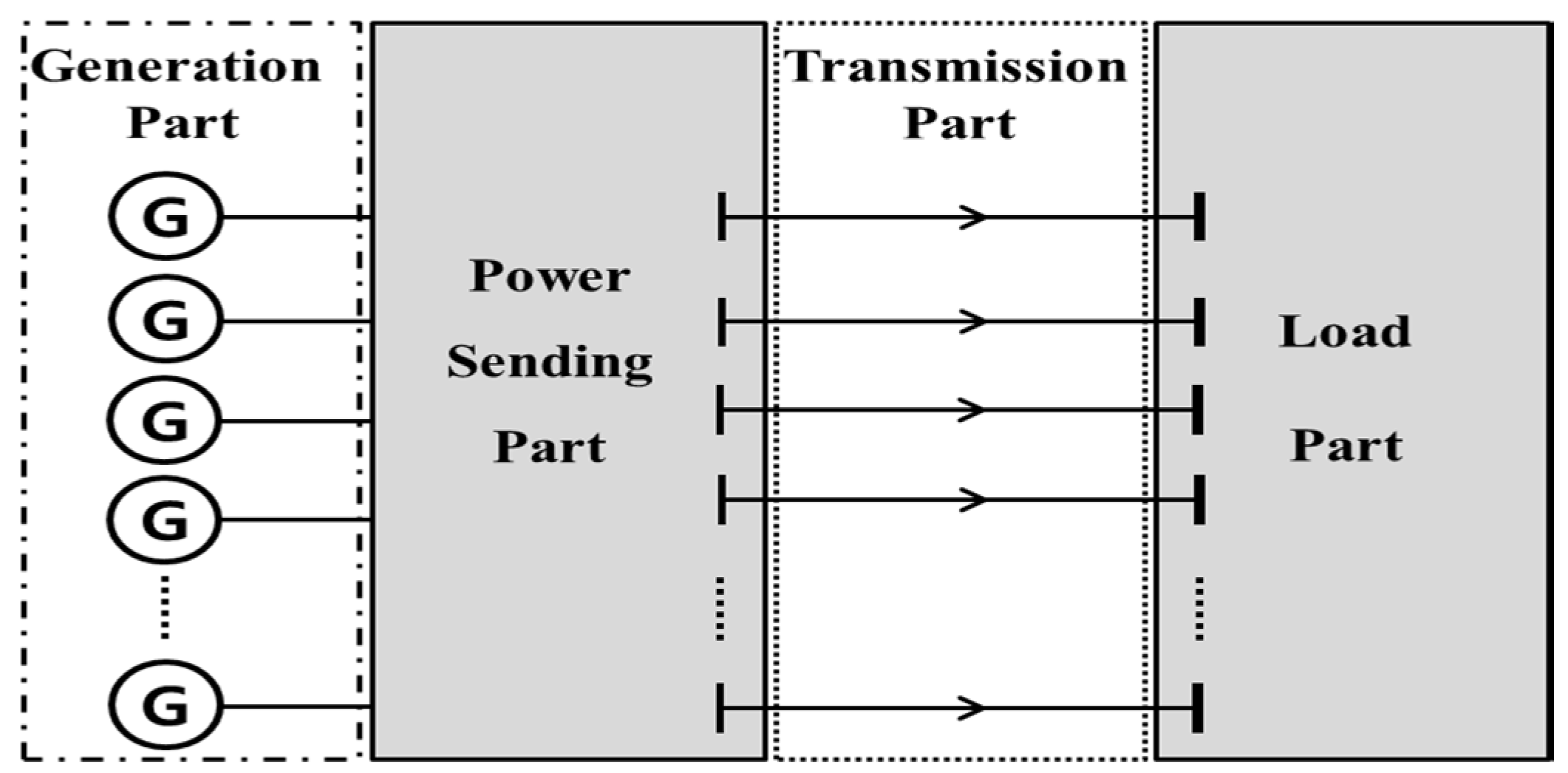
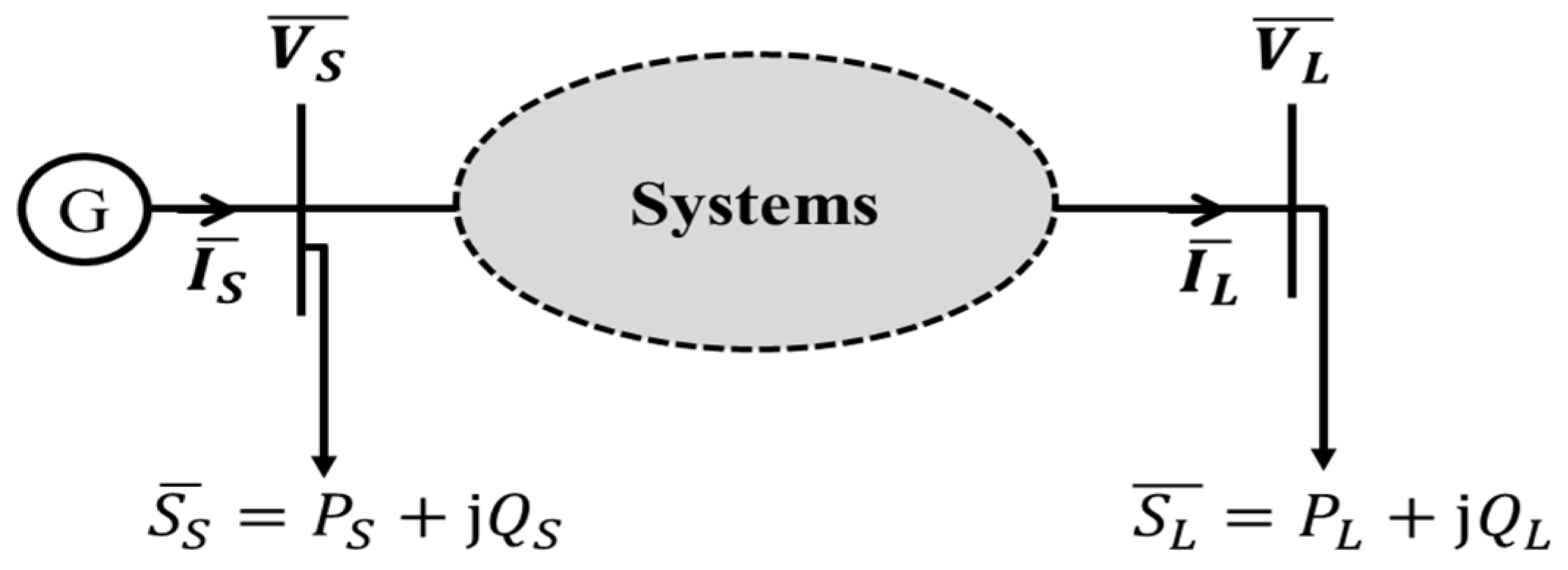
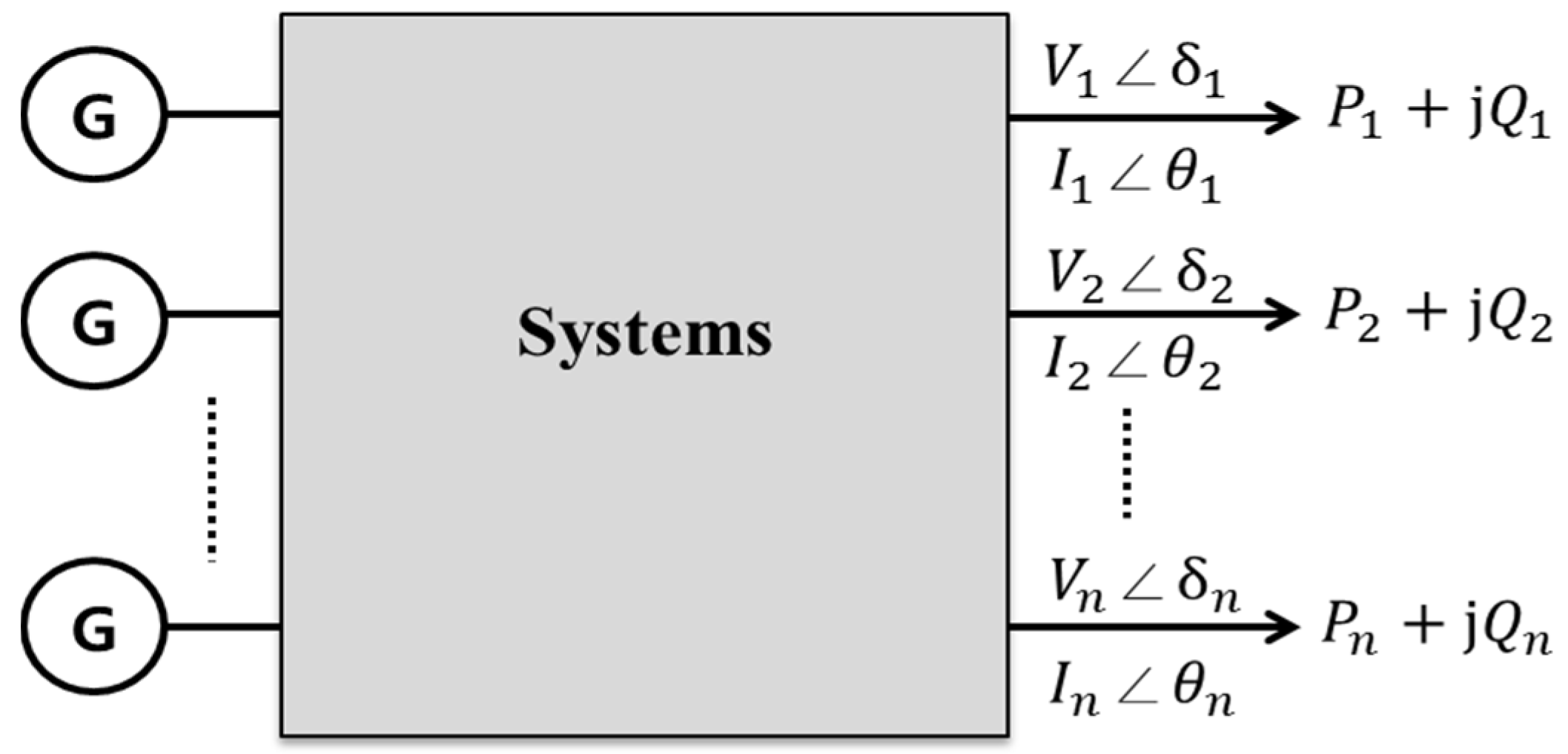
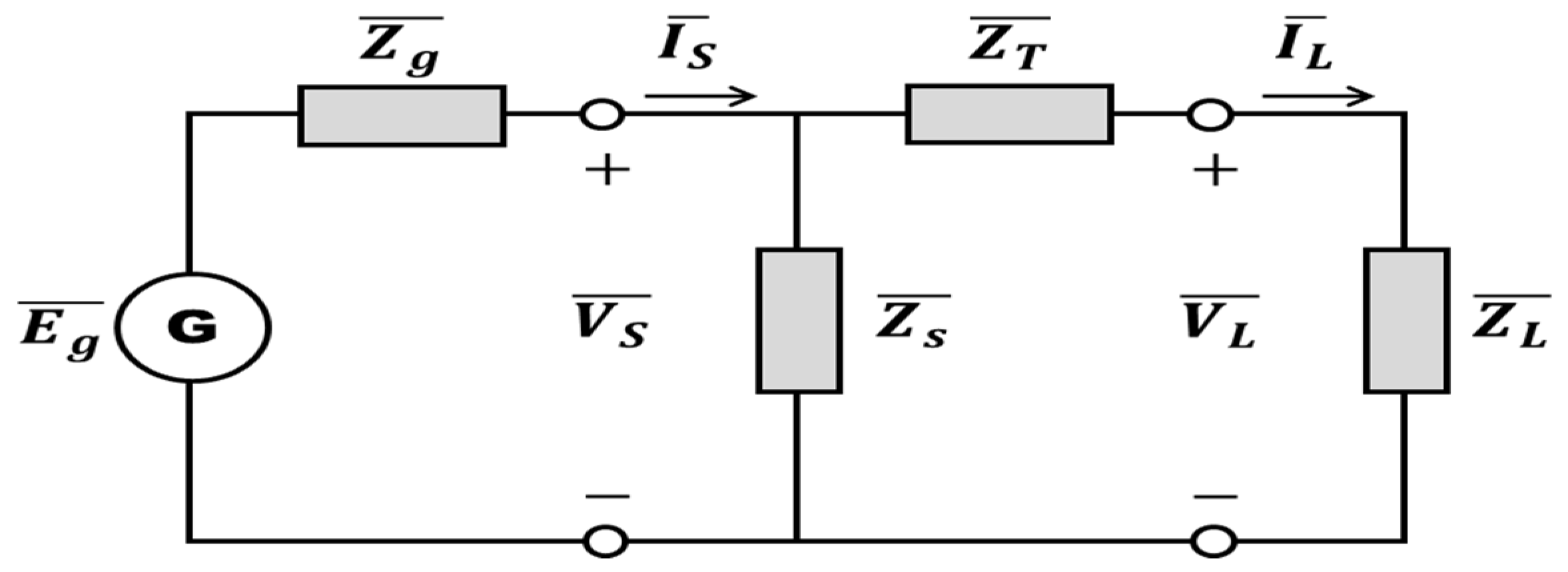
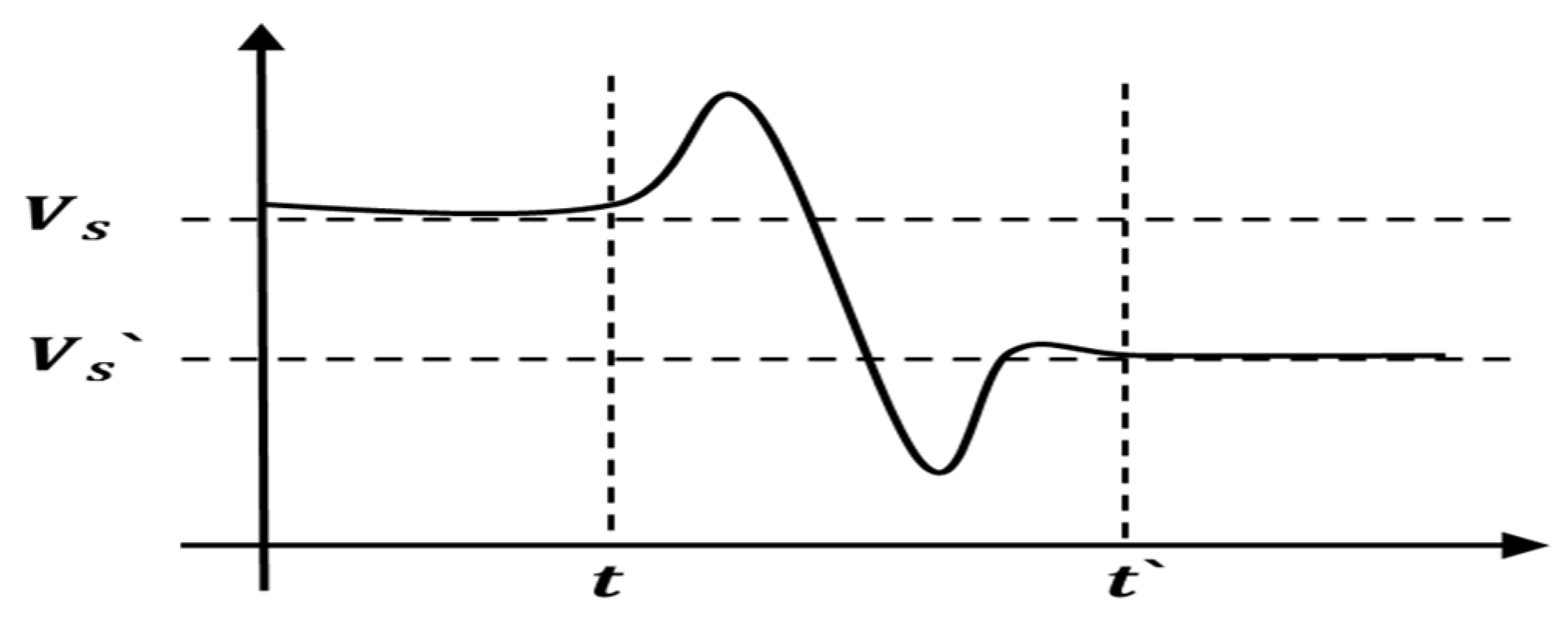



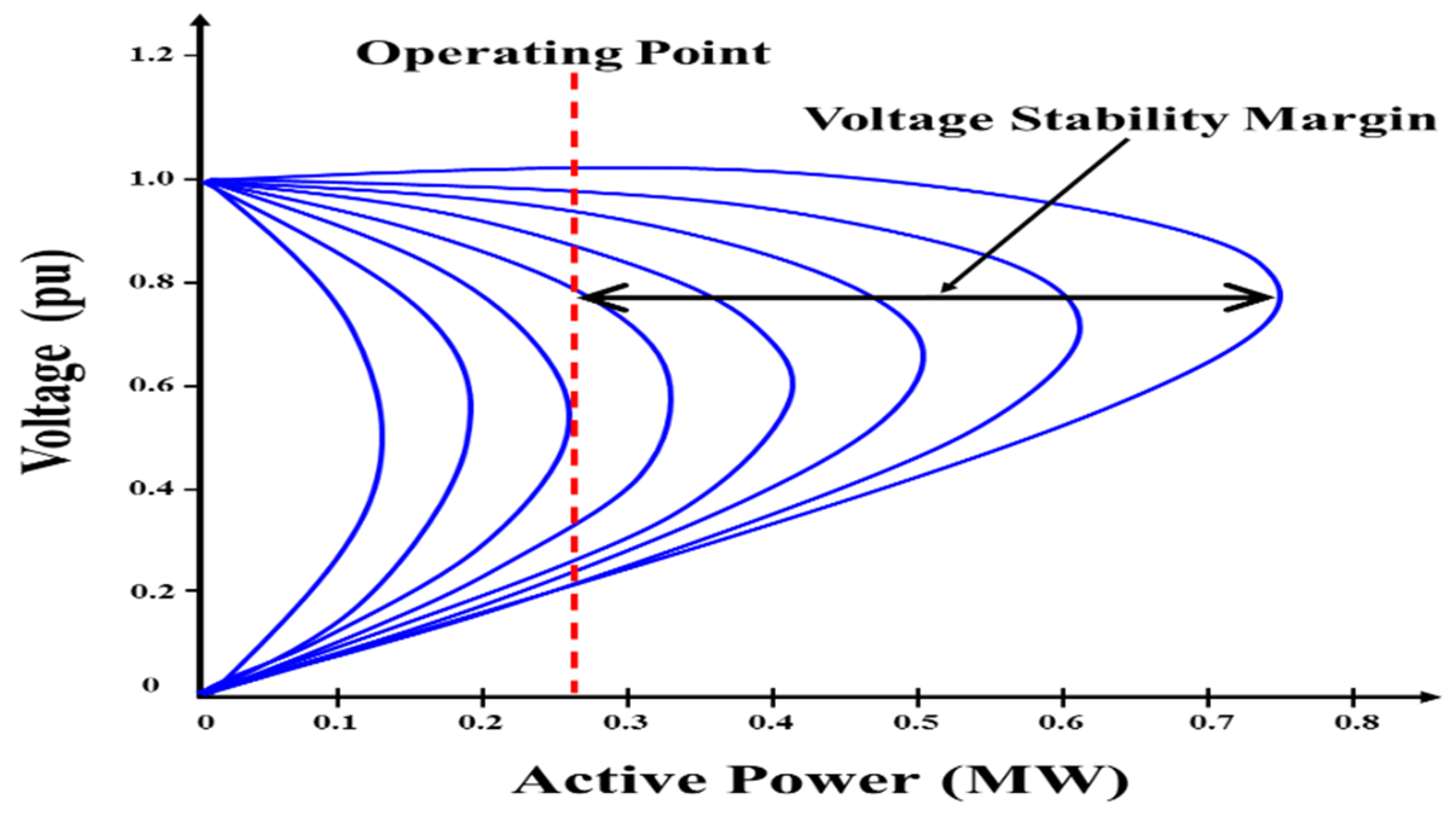
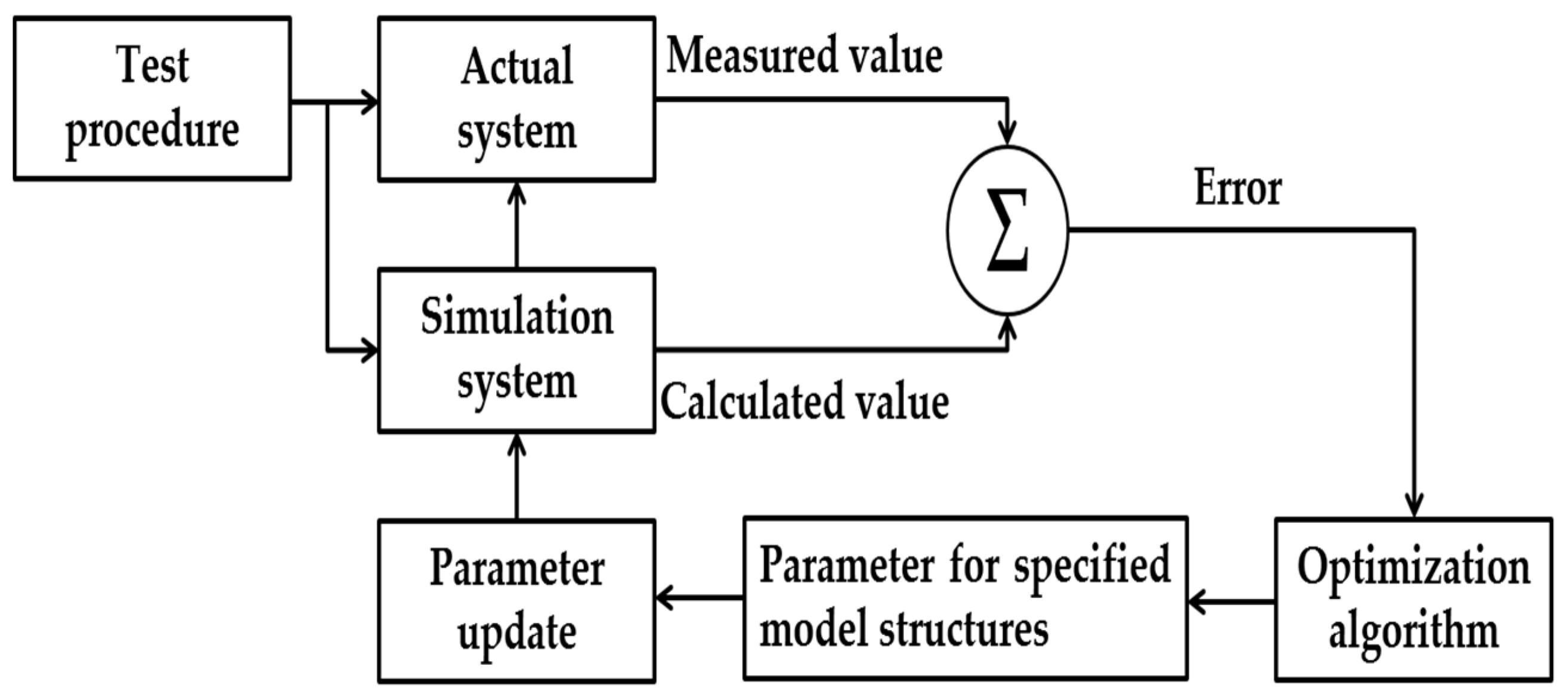
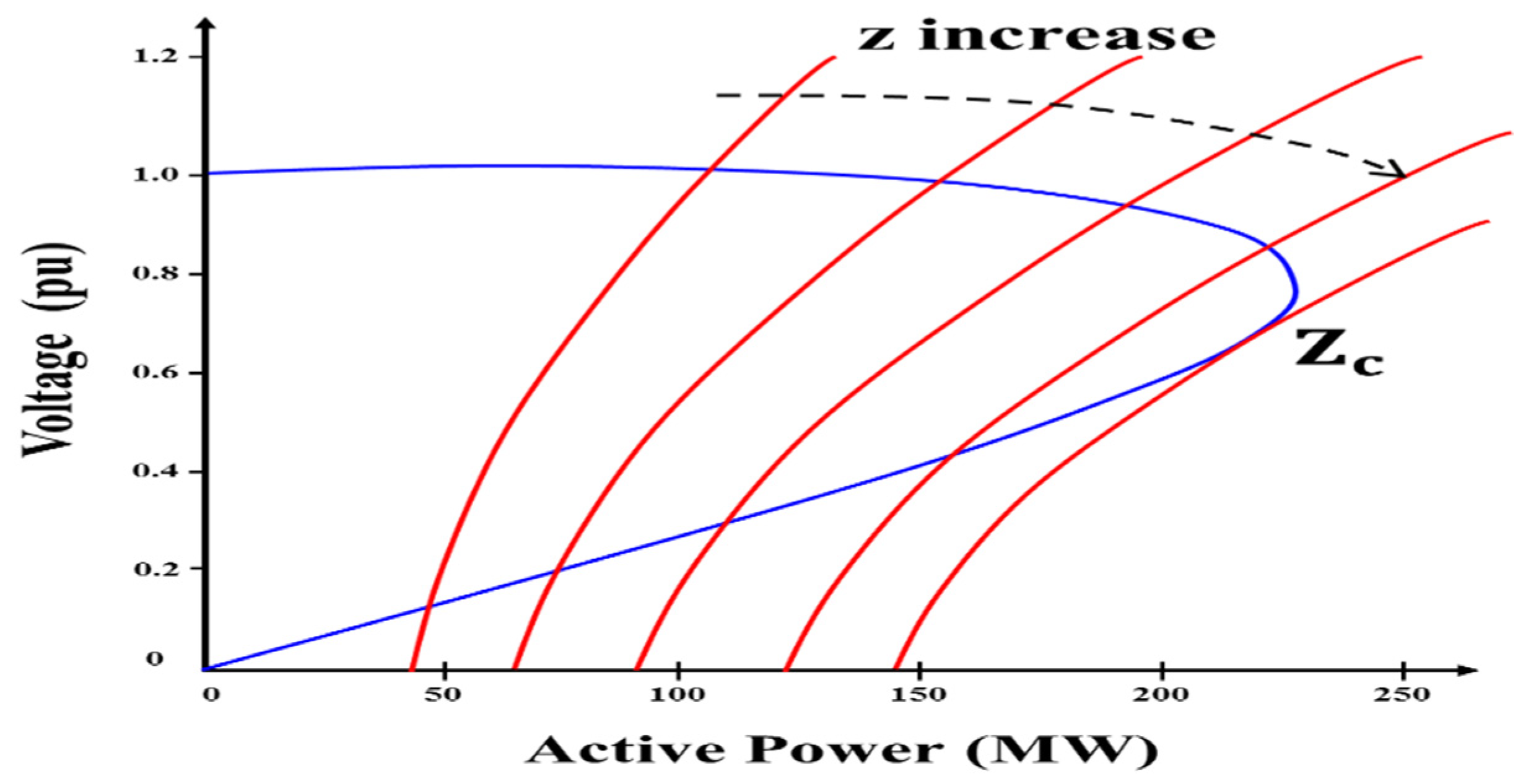

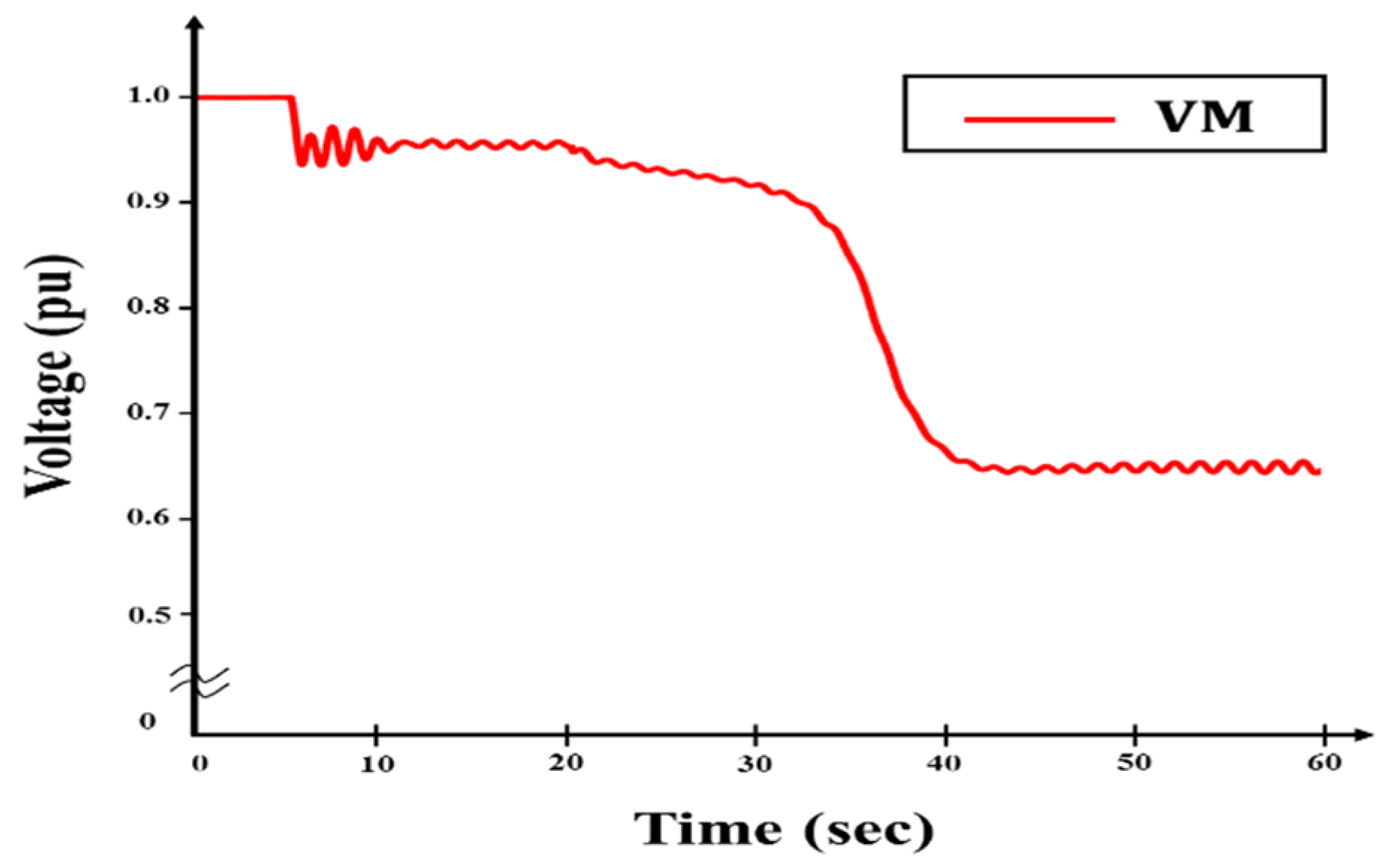
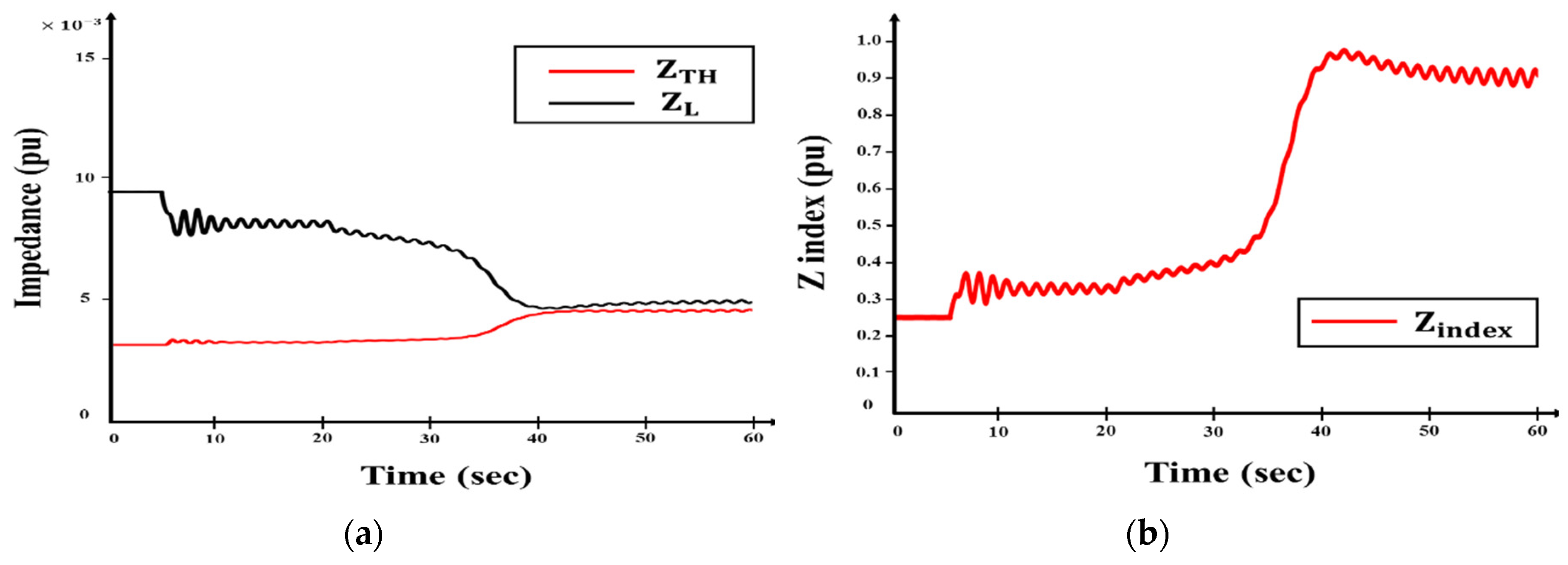
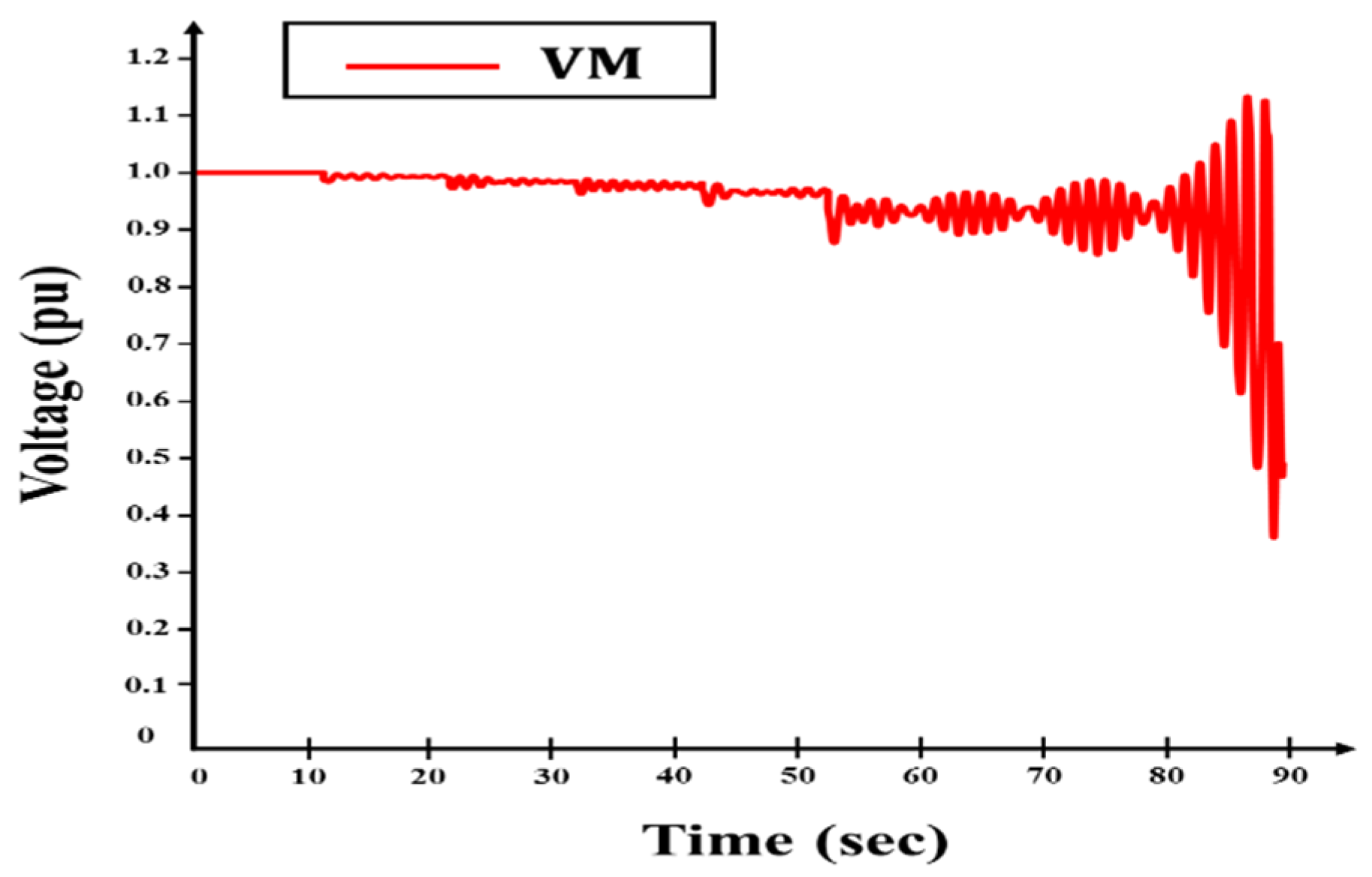
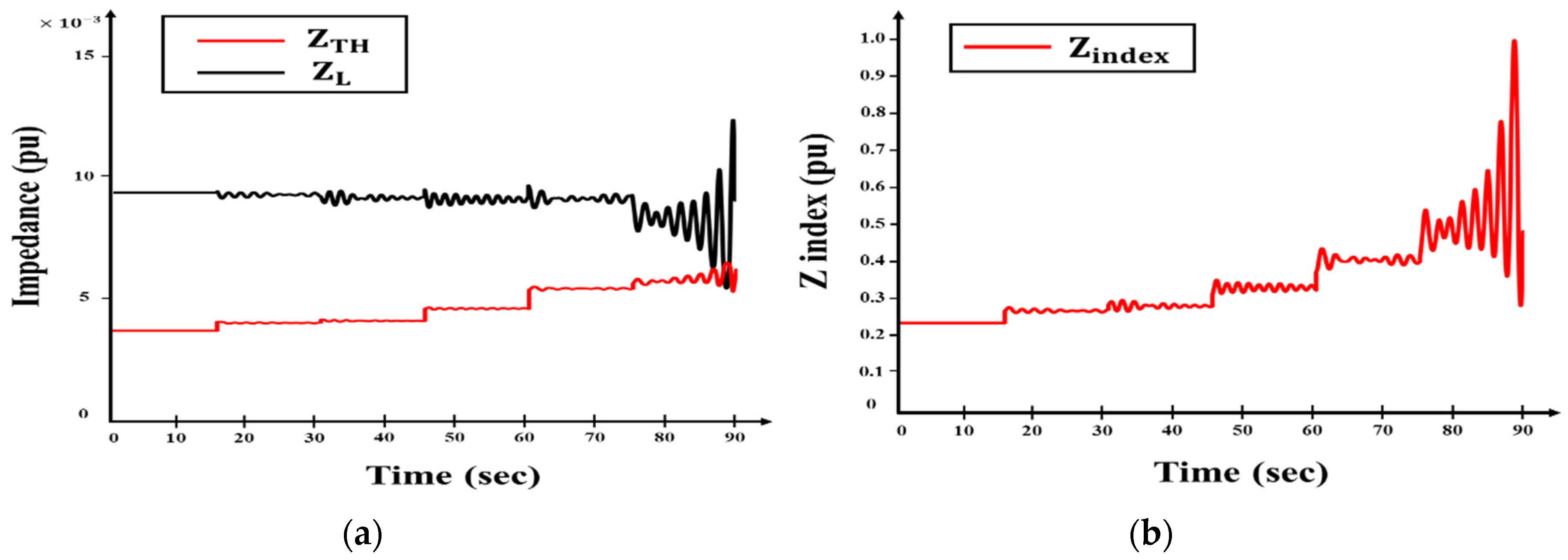

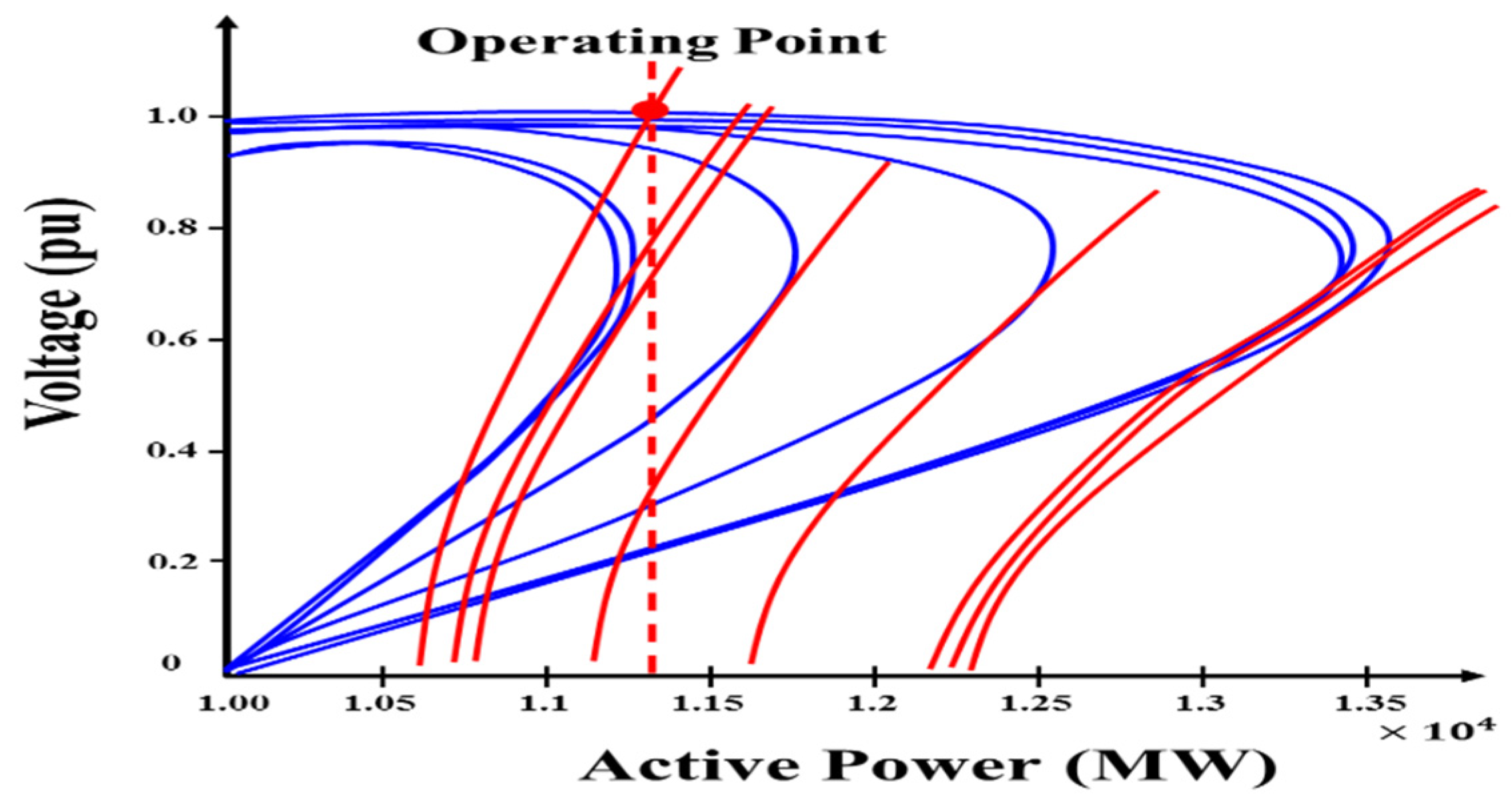

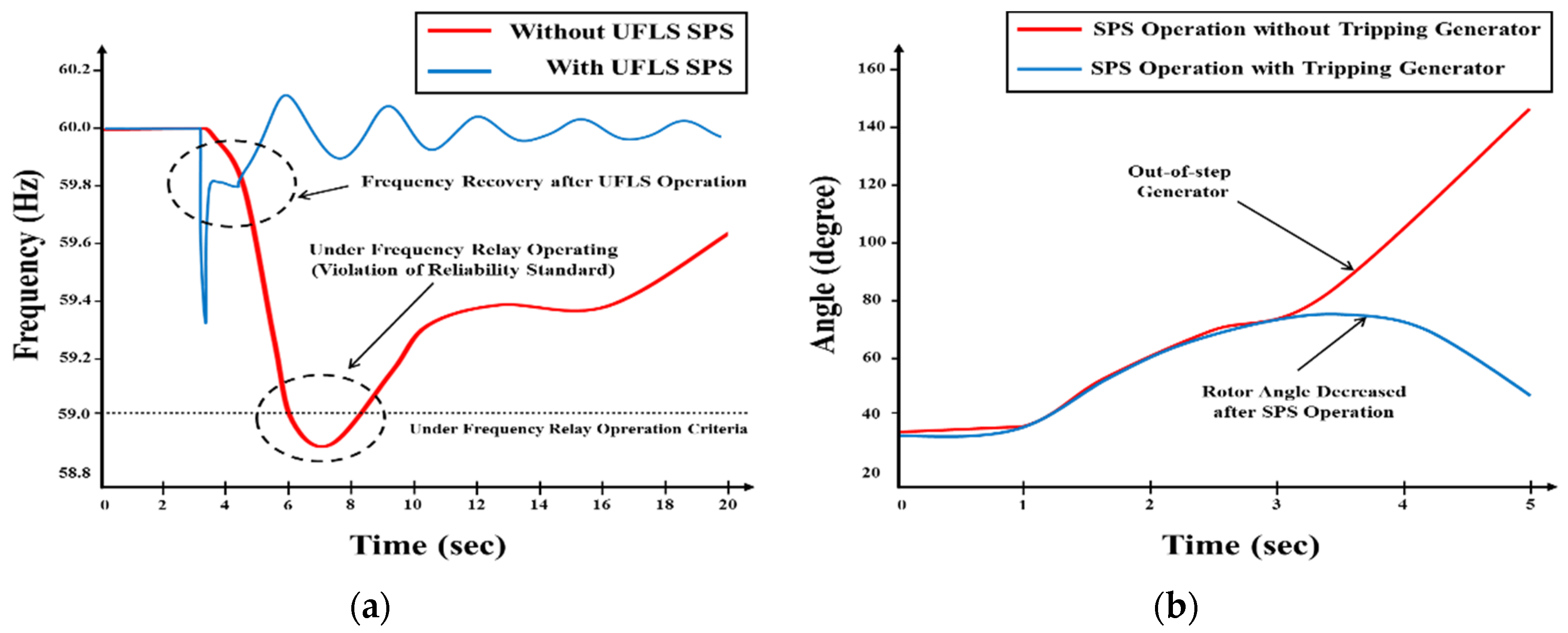
| List | Time (s) | Contingency Line | Circuits |
|---|---|---|---|
| 1 | 10 | 1020-5010 | 2 |
| 2 | 20 | 4010-6030 | 2 |
| 3 | 30 | 4400-6950 | 2 |
| 4 | 40 | 4650-4950 | 2 |
| 5 | 50 | 4450-4650 | 2 |
| Time (s) | Margins (MW) |
|---|---|
| 0 | 2177 |
| 10 | 2080 |
| 20 | 2045 |
| 30 | 1191 |
| 40 | 429 |
| 50 | −44 |
| 60 | −96 |
| Time (s) | Margins (MW) |
|---|---|
| 0 | 3075 |
| 10 | 2999 |
| 20 | 2988 |
| 30 | 1873 |
| 40 | 888 |
| 50 | 291 |
| 60 | 246 |
| Classification | Voltage Stability Results (Index) | Voltage Stability Margin (MW) |
|---|---|---|
| Case 1 | Unstable (1.0) | 583 |
| Case 2 | Unstable (1.0) | 246 |
| Classification | 1st Phase | 2nd Phase | 3rd Phase |
|---|---|---|---|
| PMU Application | Wide Area MonitoringSystem | Wide Area Monitoring and Control | Wide Area Monitoring Protection and Control |
| Ensure Stability | Voltage Stability | Frequency Stability | Angle Stability |
| Countermeasure | Stability Assessment | Under Frequency Load Shedding (UFLS) | Tripping Generation Units |
© 2019 by the authors. Licensee MDPI, Basel, Switzerland. This article is an open access article distributed under the terms and conditions of the Creative Commons Attribution (CC BY) license (http://creativecommons.org/licenses/by/4.0/).
Share and Cite
Lee, Y.; Han, S. Real-Time Voltage Stability Assessment Method for the Korean Power System Based on Estimation of Thévenin Equivalent Impedance. Appl. Sci. 2019, 9, 1671. https://doi.org/10.3390/app9081671
Lee Y, Han S. Real-Time Voltage Stability Assessment Method for the Korean Power System Based on Estimation of Thévenin Equivalent Impedance. Applied Sciences. 2019; 9(8):1671. https://doi.org/10.3390/app9081671
Chicago/Turabian StyleLee, Yunhwan, and Sangwook Han. 2019. "Real-Time Voltage Stability Assessment Method for the Korean Power System Based on Estimation of Thévenin Equivalent Impedance" Applied Sciences 9, no. 8: 1671. https://doi.org/10.3390/app9081671





